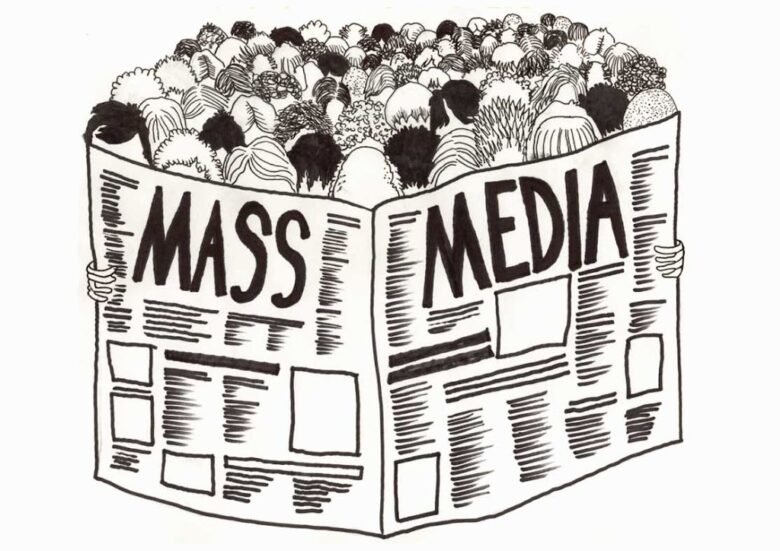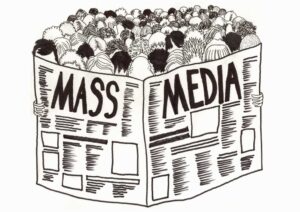Mass Media Literacy Reflections for Language Instructions
“You cannot teach a man anything, you can only help him find it within himself.” Galileo Galilei
Mass media forms thrive today. As development show itself scientifically, students experience various media forms through technologies. These flourishing materials shouldn’t be ignored; it is the role of ESL teachers to keep abreast with the present day coinciding language instructions to mass media forms as springboards of originally planned language tasks in attuning the interests of students that the real- world situation is constantly exposing them. There exist a one- to- one correspondence between technology and the mass media. As technology rises, mass media develops several forms that can be activated as operative materials in intellectually influencing interested individuals. To be able to discover these materials’ educational potentials, teachers need to discover the essence of media literacy by evaluating their viability, themselves.
Environmental changes influence learners prompting creative teacher’s initiative to employ innovation in constructing activities that cater to students’ interests for the promotion of interactive classrooms. The creation of collaborative instructional setting replaces learners’ tediousness and welcomes newly designed ideas that ensure knowledge absorption. This concept is not to absolutely replace mandated textbooks but expressing creativeness out of media forms may serve as tools to expand learning horizons of learners. Classrooms assist foundation learning not to mention that these aren’t the only outright sources of learners’ intelligence. With the breakthrough of technology currently, learners find the media in their homes. It is an educator’s accountability to guide them that these aren’t only meant for entertainment but could be extensions of learning while being amused. Thus, with the use of these media forms, English teachers may teach nonnative speakers through mass media as facilitators through any approach that they can hypothesize. However, such ingenious construction of instructional materials must be in conjunction with the curricula implemented by educational organizations where they are affiliated with. But using these materials need teachers’ readiness to aptly prepare. It is timely and pertinent that teachers’ readiness establish acceptable levels in order to maneuver learners didactically.
In here, the writer uses practical ways for teachers’ to reflect on their awareness regarding mass media literacy through evaluating present or prior exposures demonstrated to mass media forms and multimedia tools, prior and current mass media and technology material knowledge, knowledge of instructional technology tools that facilitate media materials, inter-linkages of mass media materials to the curriculum being taught, reflecting mass media materials as viable springboards for instructions, identifying some significant indicators of media literacy integration in an instruction and possessing knowledge of integrated instruction- design components for teaching through media materials alongside exemplified example of a material derived from films.
Acquiring the rudiments of mass media as a way of promoting 21st century learning can lead to assimilated awareness known as media literacy. As operationally used in this article, media literacy’s significance is to prepare educators to process varied learning styles through media forms by primarily gaining knowledge of them, understanding their contents, and analyzing their effects to learners as audience. It is perceived that through an intensive review regarding their significance and capabilities to challenge students’ critical thinking, educators can employ these materials for instructions.
These media literacy reflections can be applied to any academic discipline but the writer’s conception in here is geared through language instructions.
One of the means to appraise one’s level of media literacy is through reflecting formulated questions that determine the extent of perception.
1. Assessing former exposures to mass media and multimedia materials
Teachers may practically evaluate their experiences on mass media in and outside the classrooms.
1. Have I read various print media materials in preparing teaching inputs?
2. Have I accustomed myself with authentic materials’ principles and types?
3. Have I reviewed essential television programs /movies/videos/ documentaries, etc.?
4. Have I employed broadcast and print media materials?
5. Have I utilized print and broadcast advertisements as springboard?
6. Have I derived materials from print or broadcast media?
7. Have I obtained materials from sources I am familiar with?
8. Have I downloaded varied viable materials from the internet?
9. Have I given examples familiar to students’ current social media environment?
10. Have I disseminated the significance of mass media in teaching?
11. Have I designed tasks out of materials from other social media?
12. Have I disseminated knowledge in media forms with the facilitation of technological tools?
13. Have I integrated language functions aside from language focus in my materials?
14. Have I achieved my teaching objectives through mass media and technological tools?
15. Have I anchored my lessons with themes from media- designed materials?
16. Have I considered the genre of materials? Is it a film, an advertisement, etc.?
17. Have I employed visibly useful materials in the conduct of language lessons?
18. Have I inculcated media and technology learning theories when using these materials?
19. Have I employed mass media and technology- related materials over the last five years?
20. Have I noticed contrasting ideas in a planned lesson that aren’t suitable for the students?
21. Have I analyzed material backgrounds? Have they been connected to informative ideas?
2. Reflections of prior and current mass media and technology material knowledge
Teachers can reflect to their prior and current exposures and knowledge. Determining insufficiency of knowledge is significantly weighing and considering deficient salient points to be self-addressed.
1. Am I aware of mass-media related terminologies?
2. Am I familiar with mass media genre or classification?
3. Am I able to categorize materials’ media genre and sources?
4. Am I sensible about the distinctions between broadcast and print media?
5. Am I conscious of the materials that thrive in the Internet?
6. Am I aware of the nature of advertisements?
7. Am I able to classify news stories base from proximity, timeliness, human interest, etc.?
8. Am I able to identify the difference between media materials under authentic classifications?
9. Am I familiar with the general functions of mass media to learners?
10. Am I able to explain some restrictions or censorship to learners as audience?
11. Am I mindful of silent films, biographies, travelogue, documentaries, live reports, captions, film credits, trailers, promotional posters, loglines, film scripts, live reports, posters, movie themes, theme songs, soundtracks, cinematography, news elements, subtitles, punchlines, parental guidance, restrictions, film rating, programming, product endorsement, censorship, advertisements, obituaries, legal notices, lifeblood of the media, feedback, etc.?
3. Knowledge of instructional technology tools that facilitate media materials
The knowledge of instructional tool is vital in lesson dissemination since most mass media materials has the capability to dictate the use of technological tools which at the same time reveal and guide the strategies, teachers may employ in their instructions.
1. What are the multi-media instruments that I can operate in the conduct of my lessons?
2. What computer programs, applications, and soft wares can I manipulate?
3. What are some gadgets that create instructions to be fittingly technological?
4. How will I extract these mass media materials from its contemporary sources?
5. How will I download, redesign, enrich, reformat, and restructure a particular digital material?
6. What are the available institutional technologies aligning to my instructions?
7. Why do I use PowerPoint, Microsoft word, Movie maker, etc.to elucidate my springboards?
8. Why is it necessary to upload materials to the Website account of my students?
9. How do I upload and download teaching materials from the Website?
10. What are the proper forms of technological materials to conduct my lessons?
11. How can I possibly make a soft-copy of this material over hard copies?
12. How will I project these materials on the board while I highlight keywords in varied colors?
13. How can I display directly the short silent film from its source during a teaching session?
14. What hardware can I employ to replace a CD in the absence of a CD player?
4. Inter-linkages of mass media materials to the curriculum
1. Do they connect globally to sanctioned principles and theories of language teaching?
2. Do they link to the behavioral objectives of the English language program I am teaching?
3. Do they produce specific sub-skills to support the general objectives of my instructions?
4. Do they yield acquisition of cognitive, psychomotor and affective learning behavior?
5. Do they indicate thematic significance in the lessons’ textbooks’ chapters or units?
6. Do they indicate major significance to students’ language performance assessment?
7. Do these support students’ skill performance aside from competence?
8. Do these develop in ascending order, the thinking skills of my students?
5. Viability of mass media materials as springboards for instructions
1. Are these applicable to the suggested components of language tasks?
2. Are these viable as a springboard for language teaching?
3. Are these fitted to the right language contents to be deliberated?
4. Are these proper to the learners’ specified macro skill’s development?
5. Are these anchored towards the attainment of my lessons’ behavioral objectives?
6. Are these activities capable to suffice the relevant components of the tasks?
7. Are these accepted in terms of the principles composing authentic materials?
8. Are these possible for several tasks for the four macro skills?
9. Are these closely- related to grammar, vocabulary and the macro skills’ acquisition?
10. Are these culturally appropriate to the norms of my learners?
11. Are these able to yield systematic development of students’ critical thinking skills?
12. Are these aligned with favorable values that reinforce human behavior?
6. Some indicators of media literacy integration in language instructions
The curriculum you are following may not have stipulated the use of mass media literacy in language teaching. However, simply involving media knowledge and instructional tools in the program, implies that it is being practiced. In here, we developed some broad reflections that demonstrate media literacy applications based not only from one example but through general media materials. Here are some questions that imply the integration of media literacy in teaching.
1. Did I monitor my students’ judgement regarding themes aside from language structures?
2. Did I encourage them to express opinions through the practice of the language learned?
3. Did I offer homework in search for interesting topics connected to past lessons?
4. Did I introduce varied titles to be modified by retaining the themes?
5. Did I give them time to express ideas by varied media such as posters, drawings, etc.?
6. Did I present the sentence’s active mood favorable for information dissemination?
7. Did I discuss credible sources of ideas about modern learning to be surfed?
8. Did I employ varied mass media genre texts in my instructions?
9. Did I enrich learning through related visual and auditory media?
10. Did I utilize modern materials to reinforce and motivate my students to the current lesson?
11. Did I link examples in real -life contexts such as the siege happening in Syria?
12. Have I given them the privilege to speak or write an essay of their judgement or views?
13. Did I provide activities for students to express ideas by dramatizing, news casting, etc.?
14. Did I deal with hyponyms of the script that spurred discussions of terms in varied contexts?
15. Did I present social media as a way of featuring information and/or ideas?
16. Did I introduce critical thinking through a springboard in an ascending level?
17. Did I use television such as CNN, BBC, and Aljazeera news as tools in listening and writing?
18. Did I familiarize them on informative websites such as the disadvantages of virtual games?
19. Did I introduce a lesson through a material direct from the YouTube?
20. Did I enable evaluation of two contrasting culture, people, and places from media sources?
21. Did I assign an activity where computer applications are used to identify answers?
22. Did I display a graph for students to reflect and react regarding an information from media?
23. Did I encourage my students to express views from a video by producing their own versions?
24. Did I provide a material about mass media as a global way of disseminating information?
25. Did I give them an activity to evaluate the disadvantages of a particular advertisement?
26. Did I offer them an opportunity to provide defenses base from pictures, scenes, etc.?
27. Did I instill the idea that all movies aren’t quality-made during a discussion on films?
28. Did I incorporate the idea that children watching a show on TV needs guidance from elders?
29. Did I monitor suggested solutions during debates on issues that affect the present society?
30. Did I censor some uttered languages and displayed scenes from films to be watched?
31. Did I use materials within students’ level of interests, understanding and cultural upbringing?
32. Did I present a theme contradicting beliefs or religion? Is this acceptable in media literacy?
33. Did I plan, prepare and execute my media materials for instructions carefully?
34. Did I give background of the materials before proceeding further to demonstrate lessons?
7. Knowledge of integrated instruction design components for the media material
The teaching process entails some elements to be used in organizing lessons. Despite a common lesson plan formats, there are some components be familiar with as illustrated with examples. These design components are dependent upon the type of material to be employed for instructional designs and terminologies applied may vary institutionally. The components will be elucidated by media material from films trailer, particularly a script.
Institutional Learning Components
Input’s name: The Great Raid’s trailer’s script
General Instructions: Read the script of the trailer then watch and listen attentively.
Background information. During the world war two, the Philippines is one among the third world countries occupied by the Japanese Imperial Army. Japan then was an ally of Communist Russia.
Behavioral Objectives or intended outcomes
1. Note the events that occurred among the interspersing scenes in any order. (understand)
2. Sequence the events that you noted from the trailer. (analyze)
3. Write a narrative paragraph from the sequenced events. (create)
4. Use indirect speech and transitional expressions to write a paragraph. (apply)
5. Present an opinion regarding the effects of war. (apply)
The enclosed order thinking skills elucidate distributed order thinking skills based from the behavioral objectives or intended outcomes. All administered lessons are expected to produce outcomes. The outcomes are reflected in the specific objectives of teachers. These specific objectives are derived from order thinking skills’ sub-skills. These will indicate students’ performance levels.
Media material classification: printed material (script), listening and viewing material (trailer)
General Mass media Input’s genre: a film
Specific mass media Input (s): action film’s trailer’s script and scenes
Language Focus: indirect speech, and transitional expressions
Language functions: sequencing events, expressing sequenced Ideas and opinions
Target skills: listening and writing
Task output(s): narrative paragraph writing,
Opinion Monitor: Reactions of students on the devastating effects of war
The Great Raid trailer’s script
General Douglas Mc. Arthur: I am here to tell you man that you finally got a mission worthy of rangers. When you push through our front line / and rescue, 500 Americans prisoners of war. Before you start congratulating yourself, remember you haven’t achieved the damn thing in. With the best training and best proven in this battalion in the whole army, this is your one chance. Do something about it. I mean, one chance. Is that clear!
American Rescue battalion: Yes, sir!
Voice over: They were husbands, sons, and fathers… And so with the man inside
POW soldier: I spend the last three years thinking along the words I want to say to her.
Japanese Imperial army officer: This woman is the head of anti-front movement!
Japanese soldier: Who do you think smuggles our medicine into the camp?
Guerilla member: That’s not enough!
Woman: Let’s get out of here! It’s a setup!
Voice over: Their mission was almost certain to fail.
American Rescue Team Soldier:… we cannot guarantee the safety of the prisoners. Ten thousand at the river, Ten thousand wander by. I think we need a little miracle…
Japanese Imperial army officer: She stayed behind in the Philippines to be near you.
Do you think you have the reason to survive this war?
POW soldier: I like to be here for your surrender.
Voice over: But when face with the unthinkable!
American rescue team Member: As we advance in the area, I believe the Japanese will murder the prisoners.
Voice over: They would try the impossible… Miramax film presents the true story of the greatest rescue mission ever attempted.
POW soldier: Dear Margaret, while it comforts it’s been to know there’s someone who desires our lives more than our enemy desires our deaths. Without there is, there couldn’t be your love.
Voice over: In the moment in time, when men of honor become soldiers of destiny… there’s a prize for freedom. A prize -some are willing to pay.
To be able to gauge the effectiveness of your lesson through a mass media springboard, it is suggested to reflect on these questions.
1. Did I consider the components during the manipulation of media instructional materials?
(input, instructions, background information, objectives, media material classification, specific mass media input: specific mass media input’s genre: language focus: language functions target skills, task output(s) )
2. Were my objectives specifically expressed?
3. Did I variate my order thinking skills based from my specific objectives?
4. Were my objectives obviously attained?
5. Did the objectives synchronize with the evaluation which is the output itself?
6. Did I process the language focus specifically, transitional expressions, direct and indirect speech?
7. Were the language functions observably attained?
8. Did I introduce the procedures before the writing activity?
9. Did I exemplify topic sentence, supporting details and concluding sentence before writing?
10. Did I provide them a chance to express their ideas about the destruction of war?
11. Was the input appropriate for the language focus, language functions and outputs?
As the 21st century clock ticks to create environmental configuration yielding phases of transformation, mass media productions grow in fruition due to the advent of rising technologies that constantly influenced them. It is widely-known that while technology blossoms globally, mass media forms emerged. We obviously witness these overwhelming breakthroughs brought about by technologies on television, films, radio, theater arts, print and online publications, Internet sites, computers, laptops, phones, among others technological inventions. Learners are habitually exposed to these environmental changes. To make these dynamically existing- reforms academically significant, educators inclined in cultivating students’ minds have the chance to innovate methods through empowering these mass media and technology-produced materials as inputs to be reflected in English language curriculum, instructions and assessment. However, these materials’ viability do not rely on the interests of teachers alone; teachers are guided by the principles of media literacy that has to be learned, understood and analyzed. This has been written to reflect on some applied rudiments of media literacy geared to language instructions.
Article Source: http://EzineArticles.com/9798522




